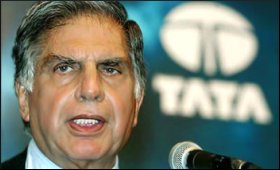|

|
Ratan Tata: Responsible leadership, conscious capitalism
|
|

|
|
| Top Stories |
 |
|
|
|
Santhosh Babu | 07 Jan, 2013
Much is written and known about the business success of the Tata Group,
the global acquisitions and Ratan Tata's role in them. Here's a look at
Tata, who steps down as chairman of this $100-billion global empire
Friday, not just as a successful business leader but also as an ideal
role model who is responsible and authentic, while integrating inner
values with outer actions.
Tata is exemplar of a leader who is
committed to "triple bottom line" - whose inner values and outer actions
demonstrate an evolved, higher level of responsible leadership. Triple
bottom line suggests that companies should be preparing three different
results.
One is the traditional measure of corporate profit,
driven by profits. The second is the bottom line of a company's people
account, a measure in some shape or form of how it contributes and deals
with people inside and outside. The third is the bottom line of the
company's planet account, of how environmentally- and
socially-responsible it has been.
Most leadership theories focus
on three outer aspects of leaders: Who have a powerful Vision, align
every stakeholder around that vision and execution of that with
excellence. While Tata did all the three things, what makes him
different and superior is his inner qualities -- the being part of
leadership.
When Tata launched the small car Nano, it reflected a
leader's inner values, influenced by his outer behaviour. Tata and his
group held a bigger purpose close to their heart: Nation building and
employment, while driving operational efficiency and profitability. "At
the Tata group, we are committed to improving the quality of life of the
communities we serve," read the purpose statement of the group. "Anyone
who visits Jamshedpur will know the meaning of this purpose statement
and how well this statement is expressed and executed there," said Tata.
There
are three characteristics that I have noticed among leaders that make
them conscious, responsible and effective leaders -- Tata demonstrates
all the three.
ONE: Leader has a bigger, higher purpose for you
and your organization that expresses responsiveness to community. While
some organizations do create the higher purpose, they do not
operationalise that. In the absence of translating the higher purpose
into actions, these statements become static and meaningless, limited to
websites and decorating boardrooms. Individuals and organizations that
have imbibed their higher purpose experience more meaning in their life
and fulfillment. An organisation that has a well-articulated and an
operationalised higher purpose would create sustainable business
success, employee loyalty, satisfaction and a sense of pride. Tata group
is an ideal example of all that.
TWO: Leader uses creative
rather than reactive tendencies to get results. Some people achieve it
using reactive competencies and tendencies like controlling,
manipulating, pleasing and complying. While some others achieve similar
or better results using creative tendencies like relating, self
awareness, purposeful actions, and authenticity. If an organisation is
only interested in driving financial results, they might be doing this
by using reactive competencies. Results can be achieved using multiple
motivational drivers. Someone who is extremely insecure and controlling
will use those tendencies to drive results. Tata used more creative
competencies to lead the organization.
THREE: Leaders operate
from higher order values. Robert Kegan, a professor at Harvard Graduate
School, proposed the need for leaders to scale their abilities to the
higher orders so that they can solve complex problems and create
personal transformation. Richard Barret, author and expert on values,
talks about seven levels of consciousness. While survival, selfish
wealth creation, power, greed, status and being liked can be considered
as lower order values, self actualisation, service, trust, honesty and
Integrity can be considered as higher end-values.
Because of the
above three qualities, it is evident India needs more Ratan Tatas and
Indian organizations that follow his and his group's footsteps for
social responsibility and conscious capitalism. We need a movement
involving the senior corporate leaders of this country to align
businesses with long-term sustainable practices and social contribution.
There is none other than Tata who could drive this. His retirement from
active business role should lead to his spending more time on helping
organizations articulate and operationalise a higher purpose.
(27-12-2012-Santhosh
Babu is an expert on organisational development and a celebrity mentor
and coach. He can be reached at santhosh@odalternatives.com and twitter
@hypnobaba)
|
|
|
| |
|
|
|
|
|
|
|
hemanta mukherjee | Wed Jan 9 11:01:52 2013
new management should follow his footsteps &let's make india better.

|
|
|
|
|
|
|
| |
| Customs Exchange Rates |
| Currency |
Import |
Export |
US Dollar
|
84.35
|
82.60 |
UK Pound
|
106.35
|
102.90 |
Euro
|
92.50
|
89.35 |
| Japanese
Yen |
55.05 |
53.40 |
| As on 12 Oct, 2024 |
|
|
| Daily Poll |
 |
 |
| Do you think Indian businesses will be negatively affected by Trump's America First Policy? |
|
|
|
|
|
| Commented Stories |
 |
|
|
|
|
|
| |
|